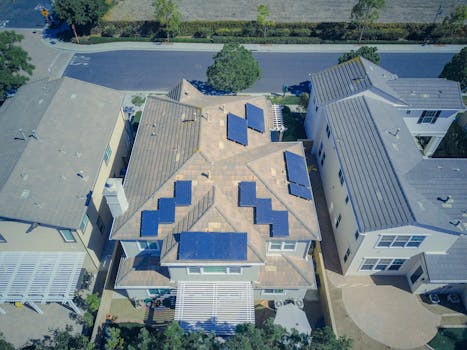“Maximize Your Solar Potential: Smart Trackers for Superior Performance.”
Solar trackers are innovative devices designed to enhance the efficiency of solar energy systems by adjusting the orientation of solar panels throughout the day. By following the sun’s path across the sky, solar trackers maximize sunlight exposure, leading to increased energy production compared to fixed installations. These systems can significantly boost the overall performance of solar arrays, making them a smart investment for both residential and commercial applications. With advancements in technology, solar trackers have become more accessible and cost-effective, offering a sustainable solution to optimize solar energy harvesting and contribute to a greener future.
Benefits of Solar Trackers for Increased Energy Efficiency
Solar trackers have emerged as a pivotal technology in the quest for enhanced energy efficiency in solar power systems. By adjusting the orientation of solar panels throughout the day, these devices ensure that panels are always positioned to capture the maximum amount of sunlight. This dynamic capability significantly increases energy production compared to fixed solar installations, which remain stationary regardless of the sun’s position in the sky. As a result, solar trackers can boost energy output by 20% to 50%, depending on geographic location and weather conditions, making them an attractive option for both residential and commercial solar systems.
One of the primary benefits of solar trackers is their ability to optimize energy capture throughout the day. Traditional fixed solar panels are limited by their static positioning, which means they can only harness sunlight effectively during certain hours. In contrast, solar trackers follow the sun’s trajectory, allowing for continuous alignment with solar rays. This not only maximizes energy absorption but also enhances the overall efficiency of the solar system. Consequently, users can generate more electricity from the same number of panels, leading to a quicker return on investment and reduced payback periods.
Moreover, the increased energy production from solar trackers can significantly impact the overall economics of solar energy systems. With rising energy costs and a growing emphasis on sustainability, the ability to generate more power translates into lower electricity bills and a reduced carbon footprint. This is particularly beneficial for businesses that rely heavily on energy, as the savings can be substantial. By investing in solar trackers, companies can not only improve their bottom line but also enhance their corporate social responsibility initiatives by committing to greener energy solutions.
In addition to economic advantages, solar trackers contribute to the longevity and durability of solar panels. By maintaining optimal angles for sunlight exposure, these systems can reduce the likelihood of overheating, which is a common issue with fixed installations. Overheating can lead to decreased efficiency and potential damage to solar cells over time. Therefore, by utilizing solar trackers, users can extend the lifespan of their solar panels, ensuring that they continue to perform at peak efficiency for many years.
Furthermore, solar trackers can be particularly advantageous in regions with variable weather patterns. In areas where cloud cover is frequent, the ability to adjust the angle of solar panels can help capture fleeting moments of sunlight. This adaptability allows solar systems to remain productive even in less-than-ideal conditions, further enhancing their reliability and efficiency. As a result, users can enjoy a more consistent energy supply, which is crucial for both residential and commercial applications.
In conclusion, the integration of solar trackers into solar energy systems represents a smart and effective strategy for improving energy efficiency. By maximizing sunlight capture, enhancing economic returns, prolonging the lifespan of solar panels, and adapting to changing weather conditions, solar trackers offer a comprehensive solution for those looking to optimize their solar investments. As the demand for renewable energy continues to grow, embracing innovative technologies like solar trackers will be essential for achieving sustainable energy goals and ensuring a greener future. Thus, for anyone considering solar energy, the addition of solar trackers is not just an option; it is a strategic enhancement that can lead to significant benefits in energy efficiency and overall performance.
How Solar Trackers Work: A Technical Overview
Solar trackers are innovative devices designed to enhance the efficiency of solar energy systems by optimizing the angle at which solar panels receive sunlight throughout the day. By adjusting the position of the panels to follow the sun’s trajectory, solar trackers can significantly increase energy production compared to fixed solar installations. Understanding how these systems work requires a closer look at their mechanics and the technology that drives them.
At the core of a solar tracker is a sophisticated control system that utilizes sensors to detect the sun’s position in the sky. These sensors, often referred to as solar position sensors, measure the intensity of sunlight and determine the optimal angle for the solar panels. This data is then relayed to a microcontroller, which processes the information and sends commands to the motors that adjust the panels’ orientation. The result is a dynamic system that can pivot and tilt the panels to maintain an optimal angle relative to the sun, maximizing exposure and energy capture.
There are two primary types of solar trackers: single-axis and dual-axis. Single-axis trackers rotate on one axis, typically oriented north to south, allowing the panels to tilt east to west as the sun moves across the sky. This type of tracker is particularly effective in regions with a high solar incidence angle, as it can capture more sunlight during the day. On the other hand, dual-axis trackers provide an additional level of movement by allowing the panels to tilt both vertically and horizontally. This capability enables them to adjust not only to the sun’s daily path but also to seasonal variations in the sun’s elevation, making them ideal for locations with significant changes in solar angle throughout the year.
The mechanical components of solar trackers are equally important in their operation. Most trackers utilize a combination of gears, motors, and actuators to achieve precise movements. The motors are typically powered by electricity, which can be sourced from the solar panels themselves, creating a self-sustaining system. Additionally, many modern trackers incorporate advanced technologies such as GPS and machine learning algorithms to enhance their performance. By analyzing historical weather data and solar patterns, these systems can predict the sun’s position more accurately, further improving energy capture.
Moreover, the installation of solar trackers can lead to significant economic benefits. While the initial investment may be higher than that of fixed solar systems, the increased energy output often results in a shorter payback period. Studies have shown that solar trackers can boost energy production by 20% to 50%, depending on geographic location and weather conditions. This increase in efficiency not only enhances the return on investment for solar energy projects but also contributes to a more sustainable energy future by maximizing the use of renewable resources.
In conclusion, solar trackers represent a smart and effective way to improve the performance of solar energy systems. By utilizing advanced technology to follow the sun’s path, these devices enhance energy capture and efficiency, making them an attractive option for both residential and commercial solar installations. As the demand for renewable energy continues to grow, the role of solar trackers in optimizing solar power generation will undoubtedly become increasingly significant, paving the way for a more sustainable and energy-efficient future.
Comparing Fixed Solar Panels and Solar Trackers
When considering the efficiency of solar energy systems, one of the most significant factors to evaluate is the type of mounting system used for the solar panels. Fixed solar panels and solar trackers represent two distinct approaches to harnessing solar energy, each with its own advantages and disadvantages. Understanding these differences is crucial for anyone looking to optimize their solar energy production.
Fixed solar panels are the most common installation type, typically mounted at a specific angle to capture sunlight. This angle is usually determined based on the geographical location and the seasonal variations in sunlight. While fixed panels are relatively simple to install and require minimal maintenance, they do have limitations in terms of energy capture. Since they remain stationary, their ability to follow the sun’s path throughout the day is restricted. Consequently, fixed panels may miss out on optimal sunlight exposure during certain times, particularly in the early morning and late afternoon when the sun is lower in the sky.
In contrast, solar trackers are designed to move and adjust their position throughout the day, following the sun’s trajectory. This dynamic capability allows solar trackers to capture significantly more sunlight compared to fixed panels. Studies have shown that solar trackers can increase energy production by 20% to 50%, depending on the location and the specific type of tracker used. This enhanced performance is particularly beneficial in regions with high solar insolation, where maximizing energy capture can lead to substantial savings on electricity bills and a quicker return on investment.
Moreover, solar trackers come in two primary types: single-axis and dual-axis. Single-axis trackers rotate on one axis, typically oriented north to south, allowing them to tilt and follow the sun’s movement from east to west. Dual-axis trackers, on the other hand, can adjust both vertically and horizontally, providing even greater flexibility in capturing sunlight throughout the day and across seasons. While dual-axis trackers offer the highest energy yield, they also come with increased complexity and cost, which may not be justifiable for all users.
Transitioning from fixed panels to solar trackers involves considering several factors, including installation costs, maintenance requirements, and available space. While solar trackers generally have higher upfront costs due to their mechanical components and installation complexity, the long-term benefits in energy production can offset these initial expenses. Additionally, the maintenance of solar trackers can be more demanding, as the moving parts require regular checks to ensure optimal functionality. However, many modern trackers are designed with durability in mind, minimizing the need for frequent maintenance.
Another important consideration is the available space for installation. Solar trackers require more land than fixed panels due to their movement and the need for spacing to avoid shading. Therefore, for those with limited space, fixed solar panels may be the more practical choice. Conversely, if land is abundant and the goal is to maximize energy output, solar trackers can be a smart investment.
In conclusion, the choice between fixed solar panels and solar trackers ultimately depends on individual circumstances, including budget, space, and energy needs. While fixed panels offer simplicity and lower initial costs, solar trackers provide a compelling advantage in energy production. By carefully weighing these factors, solar energy users can make informed decisions that align with their goals for efficiency and sustainability.
Cost-Benefit Analysis of Installing Solar Trackers
When considering the installation of solar trackers, a comprehensive cost-benefit analysis is essential to understand their impact on the overall performance of a solar energy system. Solar trackers are devices that orient solar panels toward the sun as it moves across the sky, thereby maximizing energy capture throughout the day. While the initial investment in solar trackers can be significant, the long-term benefits often outweigh these costs, making them a smart addition to solar energy systems.
To begin with, the primary cost associated with solar trackers includes the purchase and installation of the tracking systems themselves. These costs can vary depending on the type of tracker—single-axis or dual-axis—and the scale of the solar installation. Single-axis trackers, which rotate on one axis, are generally less expensive and easier to install than dual-axis trackers, which can adjust both horizontally and vertically. However, the latter can yield higher energy production, particularly in regions with varying sun angles throughout the year. Therefore, the choice between these options should be guided by specific site conditions and energy production goals.
In addition to the initial costs, it is crucial to consider the operational and maintenance expenses associated with solar trackers. While these systems are designed to be durable and require minimal maintenance, they do have moving parts that may necessitate occasional repairs or adjustments. Nevertheless, many manufacturers offer warranties that can mitigate these concerns, providing peace of mind for investors. Furthermore, the operational efficiency gained from solar trackers often leads to a reduction in the levelized cost of electricity (LCOE), making the investment more attractive over time.
The most compelling aspect of solar trackers lies in their ability to significantly enhance energy production. Studies have shown that solar trackers can increase energy output by 20% to 50% compared to fixed installations, depending on geographic location and weather conditions. This increase in energy generation translates directly into higher returns on investment, as more electricity can be sold back to the grid or used to offset energy costs. Consequently, the enhanced performance of solar trackers can lead to a quicker payback period, making them a financially sound choice for both residential and commercial solar projects.
Moreover, as the demand for renewable energy continues to grow, the value of solar energy systems equipped with trackers may appreciate over time. This is particularly relevant in markets where incentives for renewable energy adoption are increasing, as well as in regions where energy prices are on the rise. By investing in solar trackers, property owners not only improve their energy efficiency but also position themselves favorably in a competitive energy market.
In conclusion, while the upfront costs of installing solar trackers may seem daunting, a thorough cost-benefit analysis reveals that the long-term advantages often justify the investment. The potential for increased energy production, coupled with the possibility of reduced electricity costs and enhanced property value, makes solar trackers a smart choice for those looking to optimize their solar energy systems. As technology continues to advance and the renewable energy landscape evolves, the integration of solar trackers will likely become an increasingly popular strategy for maximizing solar performance and achieving sustainable energy goals.
Q&A
1. **What is a solar tracker?**
A solar tracker is a device that orients solar panels towards the sun as it moves across the sky, maximizing sunlight exposure and energy production.
2. **How do solar trackers improve energy efficiency?**
Solar trackers can increase energy output by 20-50% compared to fixed solar panels by ensuring optimal alignment with the sun throughout the day.
3. **What are the two main types of solar trackers?**
The two main types of solar trackers are single-axis trackers, which rotate on one axis, and dual-axis trackers, which can move on both horizontal and vertical axes.
4. **Are solar trackers cost-effective?**
While solar trackers have higher initial costs, their increased energy production can lead to a quicker return on investment and lower levelized cost of electricity over time.
Conclusion
Solar trackers enhance the performance of solar energy systems by adjusting the position of solar panels to follow the sun’s trajectory throughout the day. This dynamic alignment increases energy capture, leading to higher efficiency and greater overall energy production compared to fixed systems. By optimizing sunlight exposure, solar trackers can significantly improve the return on investment for solar installations, making them a smart choice for maximizing the benefits of solar energy.




